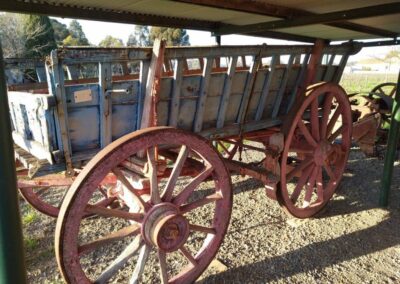“The worst frosts in 55 vintages” have recently destroyed crops, devastating both wineries and growers.1 Farmers in Light Pass 100 years ago knew exactly how that feels. They also experienced devastation caused by frosts, as time after time frosts would wipe out entire crops of fruit and grapes. While research suggests that frost events are becoming more frequent, beginning earlier, ending later, and impacting wider areas than ever before2, they are certainly nothing new.
After several seasons of disastrous losses due to frost, in 1932 the local growers in Light Pass formed the Light Pass Frost Combatting Committee. Like the Agricultural Committee, they were keen to experiment and use the latest methods, and quick to seek advice from the Council of Scientific and Industrial Research, the Weather Bureau & the Department of Agriculture3. According to a 1958 newspaper article, they “followed up all avenues opened by science and experiment”. Many types of frost protection were tried, and the committee played a vital part in bringing together the local knowledge and experience of farmers with that of the research and government organizations.

frost pot
Keeping the air warm and circulating around the base of the vines was found to be helpful in combatting frost, and a means of doing this in the early days was the use of frost pots. Shaped just like a flowerpot, the pots were filled with sump oil to the level of an insert. The insert was especially shaped so that when the oil was lit the smoke would disperse evenly into the air. Set out along the rows of vines, the frost pots would be lit when a frost attack was likely.
The committee was instrumental in pioneering the idea of orchard heating and the use of frost pots. They made them available in bulk to farmers, and at one stage there were as many as 25,000 pots in use.
Not everybody agreed on the details of their use, and there was some contention about when the pots should be lit. In a 1932 article in the Angaston Leader it was reported that “some members held the view that it was necessary to light smudges as soon as the temperature was at freezing point. Others were of the opinion that the fairly sudden thawing of the sap occurred about the time of sunrise and for this reason it was necessary only to have the fires going about an hour before sunrise.” The article goes on to say that “the committee hopes to evolve a definitive scheme to lay before the residents of the Barossa Valley in order to secure the cooperation of those both directly and indirectly involved” 4.

frost alarm
But, tucked up and sleeping soundly in their warm beds, how did the farmers know when the temperature plummeted out in the vineyards? By means of the wonderful contraption pictured above! It’s a box containing a thermometer which was attached to an alarm. When the thermometer dropped to a certain temperature, it would trigger the alarm, and awaken a saintly gentleman by the name of Gordon Boehm, who magnificently held the post of alarm officer for 46 years. At whatever ungodly hour it was, he would then notify the growers by ringing them all to warn them of an imminent frost. They would clamber out of bed and head out into the cold vineyards to fill and light their frost pots5.
Frost pots were eventually banned as they were an environmental problem and expensive to fill. Today, many grape growers use frost fans to circulate the air around vineyards and prevent the ground temperature from cooling too much. These are often solar-powered and temperature sensitive, switching on automatically when needed. Much easier!
Do a quick Google search and you will see that there are many techniques, suggestions and products available for mitigating the effects of frost on crops. However, despite years of research and scientific advancements, Jack Frost is still a fierce opponent. An opponent who struck fear into the hearts of farmers 100 years ago, and still does the same today.
References:
2. Frost protection is easier and better than ever – AgroBest
3 (4) The early1930’s were not good… – Luhrs Cottage Museum & Light Pass | Facebook
427 Oct 1932 – Study Frost Peculiarities – Trove (nla.gov.au)
5 Information from a display by Luhrs Cottage Museum.
Thanks also to Luhrs Cottage for the photographs.




